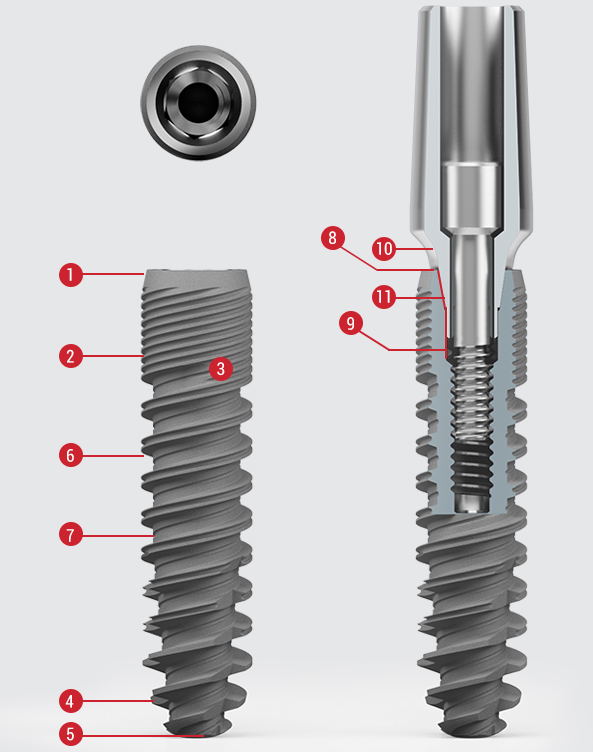窄直径植体


产品目录下载

承诺
西泰克所有的种植体系统提供10年. 了解更多»
窄直径植体
![]() ND植体为冠端直径3mm的两段式植体。尤其适合前牙区骨量不足的病例。 体部宽螺纹,冠端密螺纹以及根端的切割边缘设计让植体植入更容易。
ND植体为冠端直径3mm的两段式植体。尤其适合前牙区骨量不足的病例。 体部宽螺纹,冠端密螺纹以及根端的切割边缘设计让植体植入更容易。
- 了解更多
简单的外科操作以及多种直径设计,可以让部分需要骨增量手术的病例更加简单,同时减少了患者的费用负担
- 1斜角肩
– 促进肩部以上骨骼的生长。
– 长期植入稳定性。
– 皮质骨中力量的生物学重新分配。 - 2微槽加工
– 减轻插入过程中对皮质骨的压力。
– 皮质骨的维护。 - 3
钝化表面种植体表面经过氧化铝喷砂处理。
这种表面处理通过在骨和种植体之间提供更大和更均匀的接触面积来加速骨结合过程,同时有利于即刻加载种植体。这种处理为实现进行性小梁形成提供了一个均匀表面。
- 4积极的顶端设计
– 非常适合立即植入假牙。
– 初期稳定性。 - 5圆顶
– 插入过程中保护鼻窦底、神经管和其他重要解剖结构。
- 6双导程螺纹
– 插入率为每转 1.5 毫米。
– 初期稳定性
– 增加骨与植入物的接触
– 插入速度更快、更均匀,同时保护骨骼结构 - 7螺纹套螺纹 / 槽套槽
– 增加骨与植入物的接触
- 8平台切换
– 减少骨质流失
– 更好地表示生物宽度
– 长期美观稳定性 - 9索引十六进制
– 防旋转安全
- 10凹造型美学理念
– 非手术增厚种植体周围组织
– 促进乳头重建技术 - 11锥形连接
– 结构强度稳定性
– 减少微动 - 种植体牙冠下就位
– 阻碍骨吸收导致植入物暴露
– 非常适合美学区
– 长期美观稳定性 - 三种不同的螺纹轮廓
– 螺纹设计适应种植体深度方向上的不同骨结构
– 增强表面
– 圆润但锋利的顶点设计
植体
| ø 3.1/9 mm | ND-3009 |
| ø 3.1/11 mm | ND-3011 |
| ø 3.1/13 mm | ND-3013 |
* 了解更多ND植体信息,点击这里下载完整版产品目录
Purity and precision
Material purity and surface treatment
Material purity starts with the acquisition of raw material from only the most reliable sources of which each lot is accompanied by its own material certificate and is completely traceable at all phases of production and later use. The production facility in which all the implants and components are made is owned and operated by C-TECH and is certified to the highest standards governing the production of dental/medical devices. To maintain these standards, regular and independent audits are performed by TÜV Rheinland. All up to date certificates are available for download on the company website.
The machining of the EL implant is an intricate process due to the precision required for the Morse conical connection and the exterior complexity of the implant. This intricacy requires double the machining time that would be necessary for that of an average implant. Throughout and following each step of the production process, the implants are thoroughly cleaned in 5 seperate cleaning stages, consisting of a total of 20 cleaning cycles. This attention to cleanliness is in order to assure that no risk of any production residue is remaining on the implant surface.
The surface topography is created through a patented acid etching process. The adjacent photos made with a scanning electron microscope (SEM) demonstrate the lack of impurities on the implant surface as well the abundant surface area created through the patented acidification process.
The purity of the grade 4 titanium used for the EL implant and the surface topology were independently verified through an investigation carried out with a scanning electron microscope (SEM) by the University of Cologne and Medical Material Research Center of Berlin, Germany. The investigation demonstrated the highest level of purity and cleanliness resulting in the award of the BDIZ quality seal. This investigation is avaliable in its long form on the C-TECH website.
Precision components
The successful achievement of a Morse lock and cold weld seal in the implant-prosthetic connection depends on high precision machining. A perfect Morse connection will result in a structural integrity and strength that will be as if the 2 parts were fused together and thus will practically eliminate the gap between the implant and the abutment. Accordingly, the C-TECH components are machined to a tolerance of within 10 microns.
This mechanical fusion of the prosthetic part and the implant has 2 important benefits; prevention of the bacterial colonization of the gap, which can lead to bone loss around the implant, as well as the elimination of micro-movements between the implant and abutment and the consequent screw loosening which can lead to prosthetic failure. The SEM photos on the right show different magnifications of the tight abutment and implant connection. The final photo at the bottom, at 1000 X magnification, shows a fine line where the abutment and the implant meet. This practically nonexistent gap is less than the 1,5 microns width of the bacteria to be found in the oral cavity.












